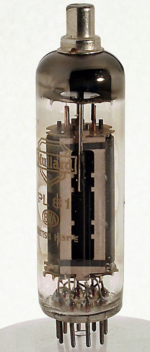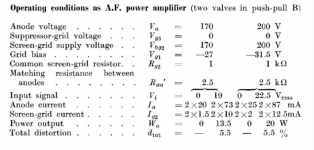There is now some heavy noise (could also be picked from a computer, my triac regulated iron and an ikea LED lamp with chinese SMPS)
Are there any rules for feedback loops to have optimal noise rejection but good musicality in the distortion and still good power? What are the usual schemes?
Are there any rules for feedback loops to have optimal noise rejection but good musicality in the distortion and still good power? What are the usual schemes?
I've got a scope which needs fixing for a channel but is accurate on X and trigger, multimeters, old smartphone signal generator as adivsed somewhere in this thread, and it's almost there
I detected the noise switching the amp on with a speaker but didn't have the time to do a sequential shutdown of all my appliances
Before measuring anything complex I'd like to sort try simple approaches first, like decoupling of some places or addition of a filter here or there
The noise may be a combination of 50Hz, HF noise from environment, and thermal noise, but it seemed a bit loud for zero volume (I'd say a bit like a radio receiver noise with less snow at equivalent volume of 10% input pot)
I'll take some time to analyze this further this weekend
I detected the noise switching the amp on with a speaker but didn't have the time to do a sequential shutdown of all my appliances
Before measuring anything complex I'd like to sort try simple approaches first, like decoupling of some places or addition of a filter here or there
The noise may be a combination of 50Hz, HF noise from environment, and thermal noise, but it seemed a bit loud for zero volume (I'd say a bit like a radio receiver noise with less snow at equivalent volume of 10% input pot)
I'll take some time to analyze this further this weekend
I have used a smartphone with free spectrum analyser to provide another tool that can be useful. It has the disadvantage of picking up ambient sound, and some of the apps don't provide much frequency resolution, but then again some can be useful.
The more informative software tool is something like REW5 in spectrum analyser mode, with input signal via a cheap soundcard electrically connected to a resistive load output on the amp. That can allow an excellent appreciation of what the noise is, and hence focus efforts to diagnose any issues within the amp.
But off course just an AC voltmeter on the speaker, and then systematically turning down/up pots, and pulling tubes, as well as sometimes soldering shorting links to key places, can usually locate the area of main concern.
Like all use of tools, it is a good idea to cross-check that what is being observed with one tool also is consistent with another measurement method. CRO's especially can show signals that are misleading - whether due to the probing technique, or grounding, or syncing, or lack of amplitude resolution, or the shortcomings of looking at a time-based signal only.
The more informative software tool is something like REW5 in spectrum analyser mode, with input signal via a cheap soundcard electrically connected to a resistive load output on the amp. That can allow an excellent appreciation of what the noise is, and hence focus efforts to diagnose any issues within the amp.
But off course just an AC voltmeter on the speaker, and then systematically turning down/up pots, and pulling tubes, as well as sometimes soldering shorting links to key places, can usually locate the area of main concern.
Like all use of tools, it is a good idea to cross-check that what is being observed with one tool also is consistent with another measurement method. CRO's especially can show signals that are misleading - whether due to the probing technique, or grounding, or syncing, or lack of amplitude resolution, or the shortcomings of looking at a time-based signal only.
Last edited:
OK, I removed feedback and placed a 1k trimmer in the middle of the bias divider to adjust to 26V, which gives respectively 12, 19, 16 and 18 mA idle current
There is no more motorboating nor hissing, I've tested with my R load and will try it out with a speaker tomorrow to make other measurements and have a look at the sine on a scope
Replace the EL81 with a matched quad fresh tubes, they're not that expensive. If you like I can trade you some used. Replacing the coupling caps to the final stage is also a good precaution. The dozen of these amps I've had over the years were all noise generators.
I already replaced by four NOS siemens tubes, but I don't see a reason to have them matched if I can have separate bias adjustment
This amp is mainly for learning and thinkering, my main objective is playing with concepts rather than having a totally restores phillips amplifier
This amp is mainly for learning and thinkering, my main objective is playing with concepts rather than having a totally restores phillips amplifier
long time no see... after nearly a year I've had some spare time to consecrate to this amp again (kids are growing)
I have finally remove everything but the phase splitter and injected some line audio right at the input grid of the splitter... and voila, pristine sound (sort of, with the old 200W sono speaker I have for testing)
That done, I as able to mount a preamplifier based on an EF86 (from a VOX AC30 schematic) and it is now playing fine with a guitar
The rest will be rewiring for getting rid of 50Hz, then adding a tone stack!
Thanks all for your tips which were valuable, after some fresh thinking I have now a better understanding of the beast...
I have finally remove everything but the phase splitter and injected some line audio right at the input grid of the splitter... and voila, pristine sound (sort of, with the old 200W sono speaker I have for testing)
That done, I as able to mount a preamplifier based on an EF86 (from a VOX AC30 schematic) and it is now playing fine with a guitar
The rest will be rewiring for getting rid of 50Hz, then adding a tone stack!
Thanks all for your tips which were valuable, after some fresh thinking I have now a better understanding of the beast...
Well done for keeping going - time and effort are great for experience, and vintage PA amps are excellent to use for learning, throwing lots of technical issues at you to then work through.
Hum can ingress in many ways - the link may give some more insight.
http://dalmura.com.au/projects/Hum%20article.pdf
Hum can ingress in many ways - the link may give some more insight.
http://dalmura.com.au/projects/Hum%20article.pdf
Thanks for the interesting read,
I'll have a complete rework of the wiring for a cleaner circuit, and I'll make sure to check various points in order to reduce noise
I'm also wanting to rework the PSU to get regulated voltages for all portions of the circuit, in order to be able to play with settings an compare operating points
I'll make sure to post some pictures here and then to report on the progress, as this may help others (I have seen numerous threads online about this patricular amplifier with only vague directions so I guess it will be appreciated)
Thanks a lot!
I'll have a complete rework of the wiring for a cleaner circuit, and I'll make sure to check various points in order to reduce noise
I'm also wanting to rework the PSU to get regulated voltages for all portions of the circuit, in order to be able to play with settings an compare operating points
I'll make sure to post some pictures here and then to report on the progress, as this may help others (I have seen numerous threads online about this patricular amplifier with only vague directions so I guess it will be appreciated)
Thanks a lot!
Yes, i now. Only it was a sign that the capacitors where bad.The oscillation was in a non feedback part and still oscillation.There had to be feedback via the powerlines, hence C17.For the H pot, this is no longer used as I removed everything but the phase splitter and push-pulls
Mona
Merits of the EL81/PL81
What is the view on the EL81 as an output tube? This is just about the only application I have seen, and they are common and cheap. Is it the top cap that puts people off?
They have that strange ceramic plate on the side, presumably for cooling, and ex-TV ones can look a bit unappealing, with brown stains from being used. Is it a cosmetic thing that makes them not popular?
What is the view on the EL81 as an output tube? This is just about the only application I have seen, and they are common and cheap. Is it the top cap that puts people off?
They have that strange ceramic plate on the side, presumably for cooling, and ex-TV ones can look a bit unappealing, with brown stains from being used. Is it a cosmetic thing that makes them not popular?
Attachments
- Home
- Amplifiers
- Tubes / Valves
- Philips EL6411/01 amplifier

